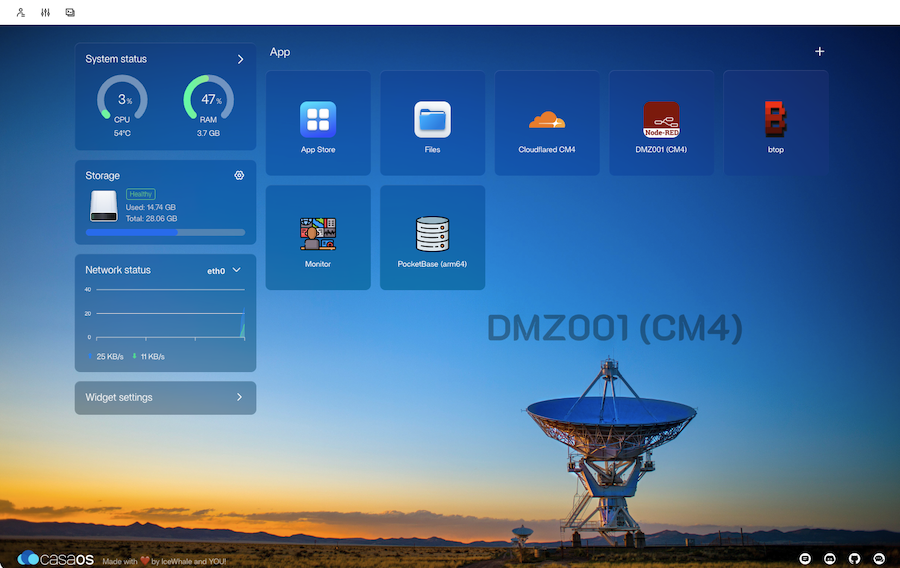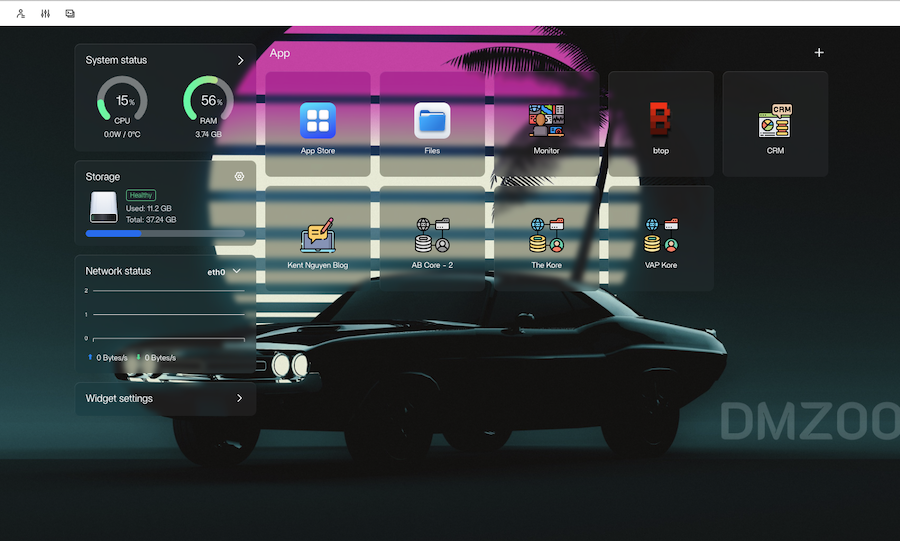After setting up our hardware and networking, the next challenge in our HomeLab journey was finding a way to manage Docker containers that didn't make me want to pull my hair out. I've tried Portainer, Docker Compose files, and even raw Docker commands, but nothing felt quite right for a HomeLab environment.
Then I discovered CasaOS, and honestly, it changed everything about how we deploy and manage services in our lab. Today, I'll walk you through why CasaOS became our go-to Docker management solution, how to set it up, and the real-world benefits that make container management actually enjoyable.
The Docker Management Dilemma
Let me paint a picture of the "before times" in our HomeLab. We had multiple Raspberry Pis running various services, each with its own collection of Docker containers. Managing them meant:
- SSH into each device individually
- Remember which containers were running where
- Manually edit Docker Compose files for updates
- No unified view of resource usage across devices
- Explaining to team members how to deploy new services (spoiler: they didn't)
I spent way too many Saturday mornings troubleshooting why a service was down, only to discover it was running on a different Pi than I remembered, or the container had crashed and I hadn't noticed.
There had to be a better way to manage our growing collection of services without requiring a PhD in Docker orchestration.
Enter CasaOS: Docker Management That Actually Makes Sense
CasaOS is what I wish Docker management had always been. It's not trying to be Kubernetes for the home – it's specifically designed for self-hosted applications and HomeLab environments.
What Makes CasaOS Special:
- Beautiful Web Interface - Clean, modern UI that actually makes sense
- One-Click App Store - Hundreds of pre-configured applications ready to deploy
- Resource Monitoring - Real-time CPU, memory, and storage usage
- File Management - Built-in file browser with upload/download capabilities
- Multi-Device Support - Manage multiple CasaOS instances from one interface
- ARM Optimized - Perfect for Raspberry Pi and other SBC deployments
But the real magic is in how it handles the complexity of Docker while keeping the interface approachable for anyone on the team.
Installation: Surprisingly Simple
Installing CasaOS is refreshingly straightforward. On any Ubuntu/Debian-based system (including Raspberry Pi OS), it's literally one command:
curl -fsSL https://get.casaos.io | sudo bash
That's it. The installer handles everything:
- Docker installation (if not already present)
- CasaOS system services
- Web interface setup
- Initial configuration
After installation, you can access the web interface at http://[device-ip]:80. In our ZeroTier setup, that means I can manage any of our Pis from anywhere using their ZeroTier IPs.
A Personal Note: I was initially skeptical of "curl | bash" installers, but CasaOS is open source, and you can review the installation script before running it. The transparency and active community development convinced me to give it a try.
The Interface: Where Beauty Meets Functionality
The first time you log into CasaOS, you'll understand why we fell in love with it. The interface is clean, intuitive, and actually pleasant to use.

The main dashboard gives you an immediate overview of system health:
- System Resources - CPU, RAM, and storage usage with beautiful graphs
- Running Applications - Quick access to all your deployed services
- Network Status - Upload/download speeds and connection info
- Storage Management - Disk usage across all mounted drives
But the real magic happens when you dive into the App Store.
The App Store: One-Click Deployments
This is where CasaOS truly shines. Instead of wrestling with Docker Compose files or hunting for the right container images, you get a curated app store with hundreds of applications ready to deploy with a single click.

Categories Include:
- Media Servers - Plex, Jellyfin, Emby
- Home Automation - Home Assistant, Node-RED, OpenHAB
- Development Tools - GitLab, Jenkins, Code Server
- Databases - PostgreSQL, MySQL, MongoDB, Redis
- Monitoring - Grafana, Prometheus, Uptime Kuma
- File Management - Nextcloud, Syncthing, FileBrowser
- Security - Bitwarden, Authelia, Fail2ban
- AI & ML - Jupyter, TensorFlow, local LLM servers
Each application comes with:
- Pre-configured Docker settings optimized for ARM/x86
- Automatic port management (no conflicts)
- Volume mapping for persistent data
- Environment variable templates
- Update management
Real-World Usage: Our Alpha Bits Setup
Let me walk you through how we actually use CasaOS across our distributed HomeLab:
Pi-Main (Primary Services)
- Directus - Our headless CMS (custom Docker deployment)
- Uptime Kuma - Service monitoring and alerting
- FileBrowser - Web-based file management
- Watchtower - Automatic container updates
Pi-Data (Database & Analytics)
- PostgreSQL - Primary database for applications
- Redis - Caching and session storage
- Grafana - Metrics visualization
- InfluxDB - Time-series data for IoT sensors
Pi-Edge (IoT & Automation)
- Node-RED - Visual programming for IoT workflows
- Mosquitto MQTT - Message broker for IoT devices
- Home Assistant - Home automation platform
- Zigbee2MQTT - Zigbee device integration
The beauty is that I can manage all of these from a single browser tab, switching between devices seamlessly through our ZeroTier network.
Advanced Features That Make a Difference
Custom App Installation
While the app store covers most use cases, sometimes you need to deploy custom applications. CasaOS makes this easy with a Docker Compose import feature. You can:
- Import existing Docker Compose files
- Create custom app definitions
- Share configurations across devices
- Version control your deployments
Resource Management
CasaOS provides excellent visibility into resource usage:
- Per-container CPU and memory usage
- Network traffic monitoring
- Storage usage tracking
- Historical performance data
This has been invaluable for optimizing our Pi deployments and identifying resource-hungry applications.
Backup and Migration
Moving services between devices is surprisingly simple:
- Export application configurations
- Backup persistent data volumes
- Import on target device
- Update DNS records
We've used this feature several times when upgrading hardware or redistributing services for better performance.
Lessons Learned and Best Practices
1. Plan Your Storage Strategy
CasaOS makes it easy to deploy applications, but think about where data will be stored. We use USB SSDs for critical data and SD cards only for the OS and temporary files.
2. Use the Built-in File Manager
The integrated file browser is surprisingly capable. You can upload files, edit configurations, and manage backups without SSH. This has made the system much more accessible to non-technical team members.
3. Monitor Resource Usage
Raspberry Pis have limited resources. Use CasaOS's monitoring to identify memory leaks, CPU spikes, or storage issues before they become problems.
4. Leverage the Community
The CasaOS community is active and helpful. If an application isn't in the official store, chances are someone has created a custom configuration you can use.
5. Keep It Simple
Don't try to run everything on one device. CasaOS makes it easy to distribute services across multiple Pis, which improves performance and provides natural fault isolation.
Performance Impact: Surprisingly Light
One concern I had was whether CasaOS would consume significant resources on our Raspberry Pis. The reality has been pleasantly surprising:
- RAM Usage: ~200MB for the CasaOS system
- CPU Impact: Negligible during normal operation
- Storage: ~500MB for the base installation
- Network: Minimal overhead for the web interface
The resource usage is well worth the management benefits, especially when you consider the time saved on deployment and maintenance tasks.
Comparison with Alternatives
vs. Portainer:
- CasaOS: Better UI, easier app deployment, HomeLab-focused
- Portainer: More enterprise features, steeper learning curve
vs. Raw Docker:
- CasaOS: Visual management, easier for team members
- Raw Docker: More control, better for automation scripts
vs. Docker Compose:
- CasaOS: GUI-based, built-in monitoring, app store
- Docker Compose: Version control friendly, more portable
For HomeLab environments, CasaOS strikes the perfect balance between ease of use and functionality.
What's Next?
With CasaOS managing our containers beautifully, we can focus on the applications themselves. In our next post, we'll dive into the specific services that power our daily operations: Node-RED for automation, databases for data management, and the various tools that make our HomeLab productive.
We'll cover deployment strategies, configuration tips, and how these applications work together to create a cohesive infrastructure.
Have questions about CasaOS setup, specific application deployments, or container management strategies? Drop us a line – I love talking about infrastructure, and your questions help shape future posts in this series.
Next up: "Essential HomeLab Applications: Node-RED, Databases, and the Tools That Matter"


